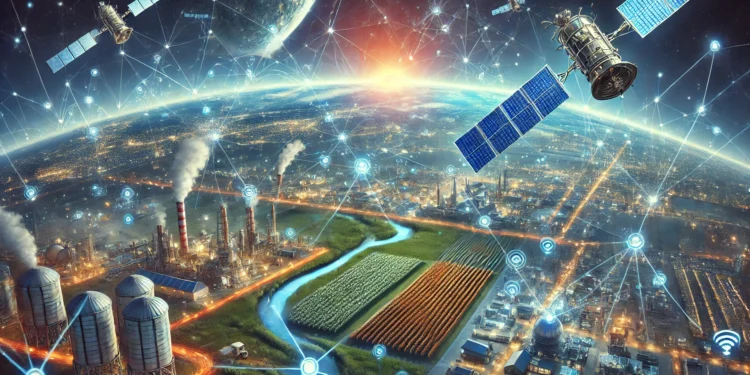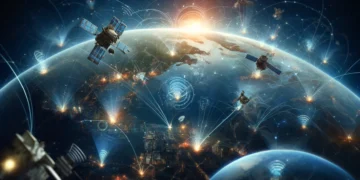Have you ever been intrigued by a self-operating car and wondered how it has a mind of its own? Huge industries are working behind the scenes to make such innovations a reality.
Automotive applications of technology are heading towards the future with the prospects of connected cars. Satellite networking reconciliation with the Internet of Things (IoT) satellite communication is enabling vehicle connectivity and functionality in any given location. While the contemporary trend is shifting toward increased interconnected and automated transportation systems, satellite networks are proving indispensable in ensuring end-to-end reliable communication for the individual as well as for industrial applications. This article will dig into connected cars, discuss satellite IoT solutions, and discuss how private satellite networks are filling the connectivity for vehicles and other disconnected verticals.
Understanding Connected Cars and Satellite Technology
What Are Connected Cars?
Connected cars are vehicles connected to the internet so they can interact with other devices, other cars, or even some infrastructure. The internet also enables sophisticated integration, such as turn-by-turn navigation, telecommunication, performance identification from a distance, and updates through the air. Nevertheless, connected cars are sometimes situated in areas where terrestrial IoT networks could be more robust or more consistent and thus require reliable satellite IoT solutions.
Key Features of Connected Cars:
- Navigation in Remote Areas: In satellite IoT solutions, drivers are provided with real-time traffic information and directions in real-time, areas of constant indicators in relatively deserted zones.
- Vehicle-to-Everything (V2X) Communication: Smart automobiles communicate with other automobiles and with the transport infrastructure, minimizing road catastrophes and optimizing traffic circulation.
- Remote Diagnostics: IoT satellite communication generates real-time performance reports, improving techniques and vehicle performance.
- Over-the-Air Updates: Cars being IoT enabled allow car manufacturers to send over-the-air updates, ensuring that the car is secure and updated.
The Role of Satellite Technology in Connected Cars
Satellite technology helps to overcome connectivity shortages because it ensures efficient communication in regions that can not be reached otherwise. IoT satellite services guarantee the encryption of automobile data from the vehicle to the cloud while improving functionality in difficult environments.
Key features include:
- Global Coverage: Satellite networks provide connectivity just about anywhere, meaning there are no black spots.
- Reliability: They can offer their service continuously, regardless of the climatic or terrain conditions.
- Low Latency: Sophisticated IoT satellite communication lowers latency, providing rapid response time.
The Role of IoT Satellite Communication in Connected Cars
Generally, networks usually perform poorly in areas that are not easily accessible to infrastructure. IoT satellite communication fills this gap and maintains connection reliability. This is useful for private cars and companies in remote areas requiring more vital communication lines.
Benefits of IoT Satellite Solutions for Connected Cars:
- Connectivity: Satellite networks make effective communication networks, especially in areas with no coverage by cellular networks.
- Security: Satellite networks are secure due to their private nature, ensuring safe transmission of information.
- Global Coverage: While terrestrial networks offer the advantage of a fixed structure, satellite technology can cover global regions, it is excellent for use when traveling and in remote areas.
Advancements in Satellite Technology
Current advancements in satellite technology are driving the connected car and enhancing the connection for far-flung businesses.
Key Innovations:
- Low Earth Orbit (LEO) Satellites: Providing minimal delay time and speedy transmission access, LEO satellites are practical for real-time options such as car location and monitoring information.
- Integrated NTN Systems: These systems integrate both land-based and non-land-based networks and can easily switch from cellular to Wi-Fi or satellite.
- AI and IoT Integration: Machine learning improves proactive evaluation and advanced applications in companies by allowing computerized operations.
- Compact Terminals: High-efficiency and low-cost satellite terminals enable industries of any scale to adopt satellite IoT solutions.
Private Satellite Networks for Remote Industries
Additionally, mining, agriculture, and energy companies, as well as other remote industries, need connectivity and activity solutions. These private satellite networks solve these problems by allowing for asset tracking and employee tracking for environmental purposes.
Applications in Remote Industries:
- Asset Management: Satellite IoT solutions make it easy to track and control equipment and cut emissions costs.
- Workforce Connectivity: Organizations that operate operating entities realize that remote employees can participate in hazardous events by using real-time communication devices.
- Environmental Monitoring: Satellite networks gather valuable information on the weather, the soil, and the effects any innovation can have on the environment.
IoT Satellite Companies: Driving Connectivity Innovation
IoT satellite companies are at the cusp of this new technological revolution, offering bespoke solutions targeting connected cars and remote operations. Some of their contributions include adaptability in their business models, compatibility with complex technological advancements, and an ability to deal with uniqueness and specificity in each work they undertake.
Key Contributions:
- Flexible Business Models: Satellite services offered through per-subscription and per-usage options bring satellite technology within the reach of more sectors.
- Technology Integration: These corporations work with satellite IoT and next-generation technologies like 5G and edge computing, allowing enhancements such as data processing.
- Customization: Optimum solutions are made to address the challenges facing industries, keeping costs low and productivity high.
Connected Cars and Sustainability
When considering sustainability, which is fast becoming an area of interest in the satellite industry, it becomes apparent that the industry is on the right track to making improvements, starting with the materials used in the construction of these houses and ending with the design of energy-efficient appliances.
Future Trends:
- Green Satellites: Technological advancements in manufacturing and satellite launching seek to have the least impact on the environment.
- Efficient Operations: Satellite IoT solutions are being developed with energy-efficient capabilities while providing high-performance levels.
- Circular Economy: Some steps have been taken to reuse the satellite parts to minimize waste and return applications.
Bridging the Gap: Connected Cars and Remote Connectivity
With increasing connectivity needs, connected cars and private satellite networks will become crucial to filling the digital divide. These technologies improve mobility and enable remote industries to have sound communication tools.
The Future of Connected Cars:
- Smart Cities: Connected cars will integrate seamlessly into smart city infrastructures, improving traffic management and reducing emissions.
- Autonomous Vehicles: A major application of satellite IoT communication will, therefore, be the management of self-driving cars, which require reliable and safe means of operation on the roads.
- Global Collaboration: Using IoT satellite communication for cross-border collaboration will foster innovation across various industries.
Conclusion: The Road Ahead for Connected Cars and Satellite Technology
Today, connected cars using IoT satellite communication and private satellite networks take a new approach to mobility and remote connection. From the perspective of automobile manufacturers, this is the golden practice for creating original concepts for the increasing need for efficient, safe, and environmentally friendly communication.
Considering gradual improvements in satellite technology, it is possible that cars and industries far from the control center will have even more potential. Industry can gain greater depth of efficiency, safety, and revolution through satellite IoT solutions toward progress in a connected society.













